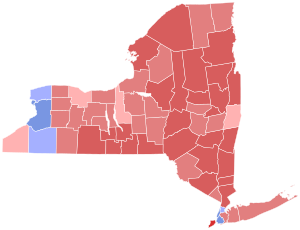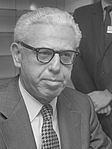
There have been 91 gubernatorial elections in the state of New York since 1777, with the most recent being held on November 8, 2022. The next election is scheduled to be held on November 3, 2026.

The 1970 United States Senate elections was an election for the United States Senate. It took place on November 3, with the 33 seats of Class 1 contested in regular elections. Special elections were also held to fill vacancies. These races occurred in the middle of Richard Nixon's first term as president. The Democrats lost a net of three seats, while the Republicans and the Conservative Party of New York picked up one net seat each, and former Democrat Harry F. Byrd Jr. was re-elected as an independent.

The 1964 United States Senate elections were held on November 3. The 33 seats of Class 1 were contested in regular elections. Special elections were also held to fill vacancies. They coincided with the election of President Lyndon B. Johnson by an overwhelming majority, to a full term. His Democratic Party picked up a net two seats from the Republicans. As of 2023, this was the last time either party has had a two-thirds majority in the Senate, which would have hypothetically allowed the Senate Democrats to override a veto, propose constitutional amendments, or convict and expel certain officials without any votes from Senate Republicans. In practice, however, internal divisions effectively prevented the Democrats from doing so. The Senate election cycle coincided with Democratic gains in the House in the same year.

The 2006 New York gubernatorial election took place on November 7, 2006, to elect the governor and lieutenant governor of New York, concurrently with elections to the United States Senate in other states and elections to the United States House of Representatives and various state and local elections, then incumbent Republican governor George Pataki chose not to run for re-election in a fourth term. Democrat Eliot Spitzer, the New York Attorney General, won the election over former Republican state Assembly minority leader John Faso. As of 2023, this is the last time the Governor’s office in New York changed partisan control.
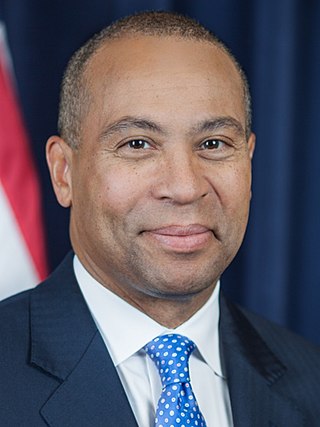
The 2006 Massachusetts gubernatorial election was held on November 7, 2006. The incumbent Republican governor, Mitt Romney, chose not to seek a second term. Polls had been mixed prior to Romney's announcement, with one poll showing Romney slightly leading Democrat Attorney General Tom Reilly and other polls showing Reilly, who was then the Democratic frontrunner, in the lead.

The lieutenant governor of New York is a constitutional office in the executive branch of the Government of the State of New York. It is the second highest-ranking official in state government. The lieutenant governor is elected on a ticket with the governor for a four-year term. Official duties dictated to the lieutenant governor under the present New York Constitution are to serve as president of the state senate, serve as acting governor in the absence of the governor from the state or the disability of the governor, or to become governor in the event of the governor's death, resignation or removal from office via impeachment. Additional statutory duties of the lieutenant governor are to serve on the New York Court for the Trial of Impeachments, the State Defense Council, and on the board of trustees of the College of Environmental Science and Forestry. The lieutenant governor of New York is the highest-paid lieutenant governor in the country.

Basil Alexander Paterson was an American labor lawyer and politician. He served in the New York State Senate from 1966 to 1971 and as secretary of state of New York under Governor Hugh Carey from 1979 to 1983. In 1970, Paterson was the Democratic nominee for Lieutenant Governor of New York on the Arthur Goldberg ticket. Paterson's son David served as governor from 2008 to 2011.

United States gubernatorial elections were held on November 5, 2002, in 36 states and two territories. The Republicans won eight seats previously held by the Democrats, as well as the seat previously held by Minnesota governor Jesse Ventura, who was elected on the Reform Party ticket but had since renounced his party affiliation. The Democrats won 10 seats previously held by the Republicans, as well as the seat previously held by Maine governor Angus King, an independent. The elections were held concurrently with the other United States elections of 2002.

Howard Joseph Samuels was an American statesman, industrialist, civil rights activist and philanthropist who served as United States Under Secretary of Commerce and Director of the Small Business Administration under President Johnson, special advisor to the campaign for president by John F. Kennedy and the administration of President Carter.

The 2010 New York gubernatorial election was held on Tuesday, November 2, 2010. Incumbent Democratic Governor David Paterson, elected as lieutenant governor in 2006 as the running mate of Eliot Spitzer, initially ran for a full term but dropped out of the race. Democratic New York Attorney General Andrew Cuomo defeated Republican Carl Paladino to become the next governor of New York.

The 1978 Arkansas gubernatorial election, held on November 7, was the first time that future President Bill Clinton was elected Governor of Arkansas.

The 1958 New York state election was held on November 4, 1958, to elect the governor, the lieutenant governor, the state comptroller, the attorney general, a judge of the New York Court of Appeals and a U.S. Senator, as well as all members of the New York State Assembly and the New York State Senate.

The 1994 New York gubernatorial election was an election for the state governorship held on November 8, 1994. Incumbent Democratic Governor Mario Cuomo ran for a fourth term, but was defeated by Republican George Pataki in an upset victory. Pataki had previously been described by the New York Daily News as "a little-known Republican state senator." The conservative New York Post attributed the result to how voters "had grown tired of the 12-year incumbent Cuomo and his liberalism."
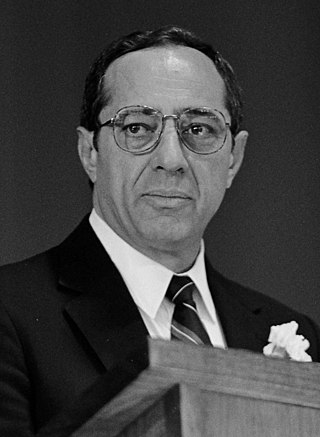
The 1982 New York gubernatorial election was held on November 2, 1982, to elect the Governor and Lieutenant Governor of New York. Incumbent Democratic Governor Hugh Carey chose not to run for a third term, which resulted in an open race. Democratic nominee Mario Cuomo, the Lieutenant Governor of New York, narrowly defeated Republican Lewis Lehrman, a banker who ran as a conservative.

The 1974 New York state election was held on November 5, 1974, to elect the governor, the lieutenant governor, the state comptroller, the attorney general, two judges of the New York Court of Appeals and a U.S. Senator, as well as all members of the New York State Assembly and the New York State Senate.

The 1970 New York state election was held on November 3, 1970, to elect the governor, the lieutenant governor, the state comptroller, the attorney general and a U.S. Senator, as well as all members of the New York State Assembly and the New York State Senate.

The 1966 New York gubernatorial election was held on November 8, 1966 to elect the Governor and Lieutenant Governor of New York. Incumbent Republican Nelson Rockefeller won reelection. As of 2022, this is the last time Manhattan voted for a Republican in a statewide election.

The 1974 New York gubernatorial election was held on November 5, 1974 to elect the Governor and Lieutenant Governor of New York. Incumbent Republican governor Malcolm Wilson, who had ascended to the governorship following Nelson Rockefeller's resignation to begin work with the Commission on Critical Choices for Americans in 1973, was defeated by Democratic Hugh Carey. Carey became the first Democratic Governor of New York since W. Averell Harriman left office in 1958 after suffering defeat from Nelson Rockefeller in the election that same year.
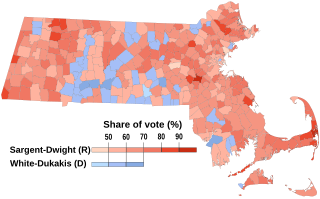
The 1970 Massachusetts gubernatorial election was held on November 3, 1970. Acting Governor Francis W. Sargent was elected to a four-year term. He defeated incumbent Boston Mayor Kevin H. White in the general election.

The 2014 New York gubernatorial election took place on November 4, 2014. Incumbent Democratic Governor Andrew Cuomo sought re-election to a second term in office, though incumbent Lieutenant Governor Robert Duffy did not seek re-election. Cuomo and his running mate, former U.S. Representative Kathy Hochul, won contested primaries, while Republican Rob Astorino, the Westchester County Executive, and his running mate were unopposed for their party's nomination. Astorino and Moss were also cross-nominated by the Conservative Party and the Stop Common Core Party.
